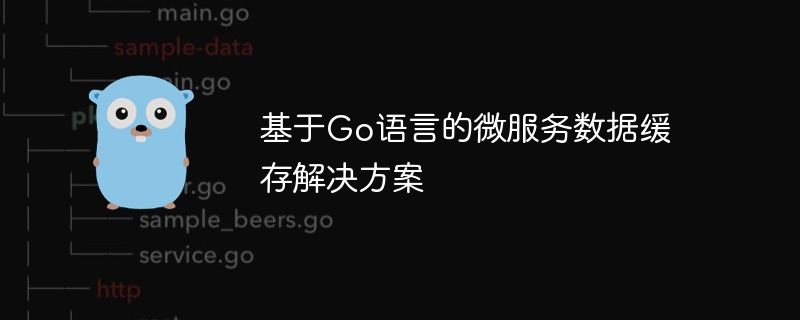

Microservice data caching solution based on Go language
With the popularity of microservice architecture and the increase in application scenarios, data caching has become an important factor in improving system performance and response. important means of speed. In the microservice architecture, data needs to be frequently shared between different services, and data caching can effectively reduce access to the database and improve system performance. This article will introduce how to use Go language to build a Redis-based microservice data caching solution and provide code examples.
First, we need to install and start the Redis server. You can download the installation package from the Redis official website and install and configure it according to the official documentation. After starting the Redis server, you can interact with Redis through the redis-cli command line tool. For example, execute SET key value to store a key-value pair in Redis, execute GET key can obtain the corresponding value.
Next, we can use Go language to build a simple microservice application to demonstrate how to use Redis to implement data caching. Suppose we have two microservices: User Service and Order Service. User Service is responsible for processing user-related operations, while Order Service is responsible for processing order-related operations. When the Order Service needs to obtain user information, it can obtain it through the User Service API. However, since frequent queries can cause performance problems, we can use Redis to cache user information.
First, we need to import the Redis client library of Go language. You can use the go-redis/redis library and install it through the go get command, as shown below :
go get github.com/go-redis/redis/v8
In User Service, we can create a function to get user information from the database. For demonstration, we can use a simple GetUserByID function to simulate the actual database query process, for example:
func GetUserByID(userID string) (*User, error) {
// 模拟查询数据库
user := &User{
ID: userID,
Name: "John",
}
return user, nil
}Next, we can define a global Redis client variable, in User This variable is initialized when the Service starts, as shown below:
var redisClient *redis.Client
func init() {
// 初始化Redis客户端
redisClient = redis.NewClient(&redis.Options{
Addr: "localhost:6379",
})
} Then, we can add caching logic in the GetUserByID function, as shown below:
func GetUserByID(userID string) (*User, error) {
user, err := getUserFromCache(userID)
if err == nil {
return user, nil
}
// 缓存未命中,从数据库获取用户信息
user, err = getUserFromDB(userID)
if err != nil {
return nil, err
}
// 将用户信息存储到缓存
err = setUserToCache(user)
if err != nil {
// 存储失败不影响正常流程,可以忽略
log.Println("Failed to set user to cache:", err)
}
return user, nil
}In the above code , we first try to get the user information from the cache, if it does not exist in the cache, then get it from the database. After obtaining the user information, we store it in the cache.
The following is the specific function to implement caching logic:
func getUserFromCache(userID string) (*User, error) {
// 使用userID作为缓存的键
val, err := redisClient.Get(ctx, "user:"+userID).Result()
if err == redis.Nil {
// 缓存未命中
return nil, fmt.Errorf("cache miss")
} else if err != nil {
return nil, err
}
// 解析缓存的值
user := &User{}
err = json.Unmarshal([]byte(val), user)
if err != nil {
return nil, err
}
return user, nil
}
func setUserToCache(user *User) error {
// 将用户信息转换为JSON格式存储到缓存
jsonStr, err := json.Marshal(user)
if err != nil {
return err
}
// 使用userID作为缓存的键,存储用户信息,并设置过期时间
err = redisClient.Set(ctx, "user:"+user.ID, jsonStr, time.Hour).Err()
if err != nil {
return err
}
return nil
}Here, we use userID as the cache key, through Redis’s GET and The SET command implements cache query and storage. Since the data obtained from Redis is of string type, we need to parse it into a User structure.
Through the above steps, we successfully built a Redis-based microservice data caching solution using Go language. In actual applications, further performance optimization can be performed based on needs, such as using cache elimination strategies and monitoring mechanisms. At the same time, you can also combine the microservice framework to encapsulate the caching logic into middleware to improve code reusability and maintainability.
To sum up, the Go language provides a wealth of third-party libraries and tools, making it easy and efficient to build microservice data cache. With the memory storage and high-speed access characteristics of Redis, we can effectively improve system performance and response speed.
(The above code examples are for reference only and may need to be adjusted according to specific needs in actual applications.)
The above is the detailed content of Microservice data caching solution based on Go language. For more information, please follow other related articles on the PHP Chinese website!




